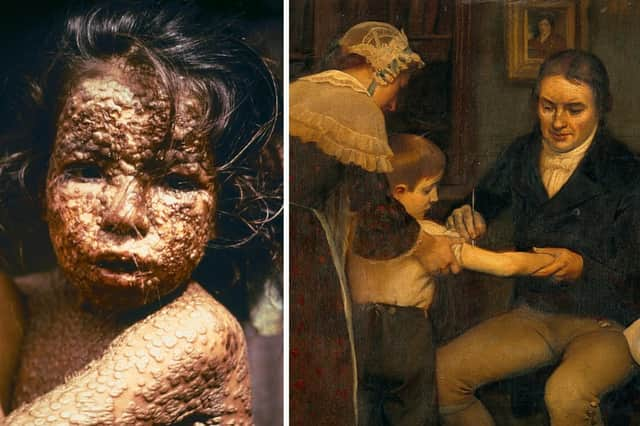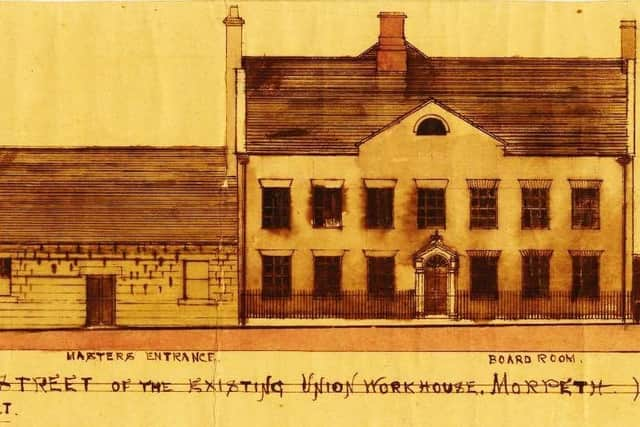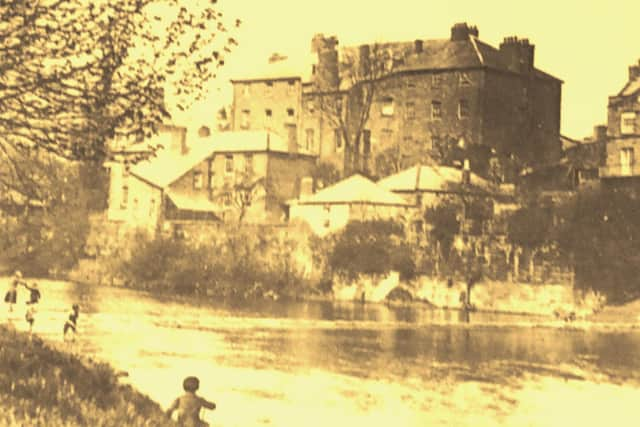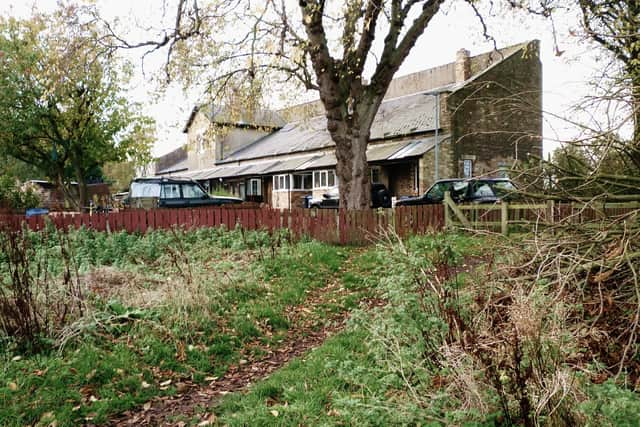Morpathia article: Smallpox and vaccination in Northumberland


“For a long period we have been fortunately exempt from Small Pox, that scourge of the human race, but towards the close of the Year it broke forth with uncommon violence, and is yet raging up to the time of this Report. Many cases have been fatal, and not a few have occurred after Vaccination; leaving it in doubt, whether this be so effectual a preventative of the Small Pox ... or what is more probable, that the Vaccine Virus has undergone some change ... and now requires to be renewed direct from the Cow; certain it is, when first introduced more Fever and Inflammation around the vesicle took place, than occurs at present.”
Inoculation with smallpox pus was introduced to England from China in 1700, the death rate being about 2%, compared with 20-30% for infections. It was well known, however, that milkmaids usually had clear skins, leading Edward Jenner to invent vaccination – inoculation with cowpox – in 1796.
Advertisement
Hide AdAdvertisement
Hide AdIn 1840, inoculation by smallpox was prohibited and vaccination made free of charge through the Poor Law. In 1853 it was made compulsory, but this was evidently a dead letter; in the 1850s and most of the 1860s the Herald never carried local stories about vaccination, only about parliament or happenings in London.


Unfortunately, there were two serious objections to vaccination. First, that people caught it despite being vaccinated. Secondly, that child deaths were often attributed to vaccination, sometimes even figuring in official inquest verdicts.
One reason was the bad habits of some vaccinators – like not wiping the needle (!) between vaccinations, so that other diseases, or even smallpox itself, were transmitted from one patient to another.
Another problem was the difficulty of getting pure lymph. The best lymph came from calves, but there must have been some difficulty with this because it was normally taken from the pustules of people who had themselves been vaccinated.
Advertisement
Hide AdAdvertisement
Hide AdOnce, a lady in London asked for lymph from a titled person – preferably from a neighbour who was a countess! The Morpeth Herald printed this as a funny story, but she was probably wiser than it gave her credit for.


In 1869, Mr John Watson, registrar for the Morpeth district, told the Board of Guardians that there were 385 unvaccinated children in his district. The chairman, the Rev. B.P. Hodgson, said that the epidemics of 1866 and 1867 had “very much increased the costs of the Union” and thought they should appoint a public vaccinator.
In July, Mr Harbottle, registrar for Bedlington, stated that he had about 80 children not vaccinated and “there were some who objected to it, but he would not say there were any prepared to resist the law”.
He was asked to use his “best influence” with the parents to get their children vaccinated and this pretty much remained the position in the Morpeth Union for the next 30 years.
Advertisement
Hide AdAdvertisement
Hide AdIn contrast, largely middle-class Anti-Vaccination Leagues were strong in London. In Leicester there were mass protests and at Keighley the Board of Guardians actually went to prison for not enforcing compulsory vaccination. Nothing like that happened in Northumberland.


One important issue was whether the magistrates could fine conscientious objectors repeatedly; a test case in the Queen’s Bench held that, though not explicitly stated, this was what Parliament intended.
By March 1870, the Morpeth Union had appointed vaccinators. Mr John Watson, the relieving officer for Morpeth district, who was also the vaccination officer, said that there were 400 unvaccinated children in his area. The clerk said that in such cases they should appoint prosecutors, which the Guardians duly did.
In 1871, the Herald reported an anti-vaccination meeting – or more accurately an anti-compulsion meeting – at the Primitive Methodist chapel in Burradon, followed soon after by a similar event in Cramlington.
Advertisement
Hide AdAdvertisement
Hide AdIn July of that year, the Guardians authorised Mr Watson to summons a Mr Westness, a grocer in Morpeth, who refused on principle to have his child vaccinated. Similarly, in 1874, one John Grieves, a coal miner from Shankhouse, was prosecuted at the Moot Hall for refusal to vaccinate.
He said: “I desire to protect my child from what I consider a filthy practice.” The full fine was a pound. The magistrates said they had no power to remit the fine, but reduced it to 2/6 plus costs.
In February 1875, the Morpeth Guardians resolved to summons any parents who had not complied with the law by the time of their next meeting and in March, the vaccination officers, Mr Watson (Morpeth) and Mr Waterson (Bedlington), were instructed to prosecute those who still refused.
We do not know the outcome but the following year, when Mr Watson brought summonses against six people, three prosecutions were withdrawn, presumably having complied, and one was held over. But a woman called Elizabeth Brown, of Morpeth, was fined 1/- and 10/6 costs – apparently for mere neglect rather than a matter of principle.
Advertisement
Hide AdAdvertisement
Hide AdSometimes the problem was simply that people failed to hand in their certificate of vaccination, while in other cases the doctors kept them in their pockets for months at a time.
In 1877, the Local Government Board wrote complaining about the arrears of vaccination in the rural area of the Union, outside of Morpeth and Bedlington. Dr Hedley of Felton, the vaccinator for that area, explained that he had difficulty getting pure lymph. They advised him to get it from the National Vaccination Establishment, but – as with calf lymph – that was evidently easier said than done.
In his medical report for the Dispensary for 1893, the House Surgeon, Dr J.K. Watson, mentioned a case of a disease called vaccinia. This is significant. Although nobody knows how it happened, this virus gradually replaced cowpox as the active agent in vaccinations.
In 1898, an Act was passed allowing conscientious objectors to not have their children vaccinated and in October, the Blyth magistrates received their first application under the Act, from a Mr William Scurfield of Cowpen Quay.
Advertisement
Hide AdAdvertisement
Hide AdBy 1900, smallpox came mainly from ships visiting local ports, though in Morpeth it was the lodging houses and the workhouse that presented the greatest risk. The procedure in all cases was to isolate the sick, disinfect the premises and vaccinate or re-vaccinate all contacts.
There was a case, in 1902, of a tramp staying in the workhouse. He was taken to the Isolation Hospital on the Common and the other vagrants were kept in the casual ward until the MOH, Dr Dickie, was satisfied they were no longer contagious.
In 1904, there was another outbreak in Morpeth and at the Council meeting in March it was stated that there were 14 cases so far, and Dr Clarkson had vaccinated most of the contacts.
By the 1940s, the only references to smallpox in the Herald were about closing local smallpox hospitals. In 1942, at a meeting of Morpeth RDC, Alderman Patton said: “For years they had had a hospital of their own, but had not been in use for a great number of years.”